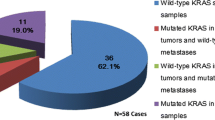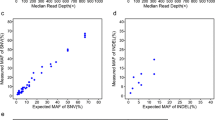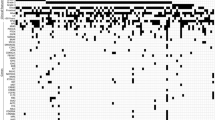Abstract
Background
Simultaneous detection of multiple molecular biomarkers is helpful in the prediction of treatment response and prognosis for colorectal cancer (CRC) patients.
Methods
A 22-gene panel consisting of 103 hotspot regions was utilized in the formalin-fixed paraffin-embedded (FFPE) tissue samples of 207 CRC patients, using the next-generation sequencing (NGS)-based multiplex PCR technique. Those 22 genes included AKT1, ALK, BRAF, CTNNB1, DDR2, EGFR, ERBB2, ERBB4, FBXW7, FGFR1, FGFR2, FGFR3, KRAS, MAP2K1, MET, NOTCH1, NRAS, PIK3CA, PTEN, SMAD4, STK11, and TP53.
Results
Of the 207 patients, 193 had one or more variants, with 170, 20, and 3 having one, two, and three mutated genes, respectively. Of the total 414 variants identified in this study, 384, 25, and 5 were single-nucleotide variants, deletion, and insertion. The top four frequently mutated genes were TP53, KRAS, PIK3CA, and FBXW7. There was high consistency between the results of NGS–PCR technique and routine ARMS-PCR in KRAS and BRAF mutation detection. Univariate and multivariate analyses demonstrated that advanced TNM stage, elevated serum CEA, total variants number ≥ 2, AKT1 and PTEN mutation were independent predictors of shorter DFS; poor differentiation, advanced TNM stage, total variants number ≥ 2, BRAF, CTNNB1 and NRAS mutation were independent predictors of shorter OS.
Conclusions
It is feasible to detect multiple gene mutations with a 22-gene panel in FFPE CRC specimens. TNM stage and total variants number ≥ 2 were independent predictors of DFS and OS. Detection of multiple gene mutations may provide additional prognostic information to TNM stage in CRC patients.


Similar content being viewed by others
References
Stewart B, Wild CP (eds) (2014) World Cancer Report 2014. International Agency for Research on Cancer (IARC), Lyon
Marmol I, Sanchez-de-Diego C, Pradilla Dieste A et al (2017) Colorectal carcinoma: a general overview and future perspectives in colorectal cancer. Int J Mol Sci 18(1):197
Dienstmann R, Mason MJ, Sinicrope FA et al (2017) Prediction of overall survival in stage II and III colon cancer beyond TNM system: a retrospective, pooled biomarker study. Ann Oncol 28(5):1023–1031
Normanno N, Rachiglio AM, Roma C et al (2013) Molecular diagnostics and personalized medicine in oncology: challenges and opportunities. J Cell Biochem 114(3):514–524
Garde Noguera J, Jantus-Lewintre E, Gil-Raga M et al (2017) Role of RAS mutation status as a prognostic factor for patients with advanced colorectal cancer treated with first-line chemotherapy based on fluoropyrimidines and oxaliplatin, with or without bevavizumab: a retrospective analysis. Mol Clin Oncol 6(3):403–408
Tops BB, Normanno N, Kurth H et al (2015) Development of a semi-conductor sequencing-based panel for genotyping of colon and lung cancer by the Onconetwork consortium. BMC Cancer 15:26
Rey JM, Ducros V, Pujol P et al (2017) Improving mutation screening in patients with colorectal cancer predisposition using next-generation sequencing. J Mol Diagn 19:589–601
Dijkstra JR, Tops BB, Nagtegaal ID et al (2015) The homogeneous mutation status of a 22 gene panel justifies the use of serial sections of colorectal cancer tissue for external quality assessment. Virchows Arch 467(3):273–278
Hadd AG, Houghton J, Choudhary A et al (2013) Targeted, high-depth, next-generation sequencing of cancer genes in formalin-fixed, paraffin-embedded and fine-needle aspiration tumor specimens. J Mol Diagn 15(2):234–247
Zhang J, Zheng J, Yang Y et al (2015) Molecular spectrum of KRAS, NRAS, BRAF and PIK3CA mutations in Chinese colorectal cancer patients: analysis of 1,110 cases. Sci Rep 5:18678
Bamford S, Dawson E, Forbes S et al (2004) The COSMIC (Catalogue of Somatic Mutations in Cancer) database and website. Br J Cancer 91(2):355–358
Carpten JD, Faber AL, Horn C et al (2007) A transforming mutation in the pleckstrin homology domain of AKT1 in cancer. Nature 448(7152):439–444
Tian S, Simon I, Moreno V et al (2013) A combined oncogenic pathway signature of BRAF, KRAS and PI3KCA mutation improves colorectal cancer classification and cetuximab treatment prediction. Gut 62(4):540–549
Hammerman PS, Sos ML, Ramos AH et al (2011) Mutations in the DDR2 kinase gene identify a novel therapeutic target in squamous cell lung cancer. Cancer Discov 1(1):78–89
Arcila ME, Chaft JE, Nafa K et al (2012) Prevalence, clinicopathologic associations, and molecular spectrum of ERBB2 (HER2) tyrosine kinase mutations in lung adenocarcinomas. Clin Cancer Res 18(18):4910–4918
Al-Shamsi HO, Jones J, Fahmawi Y et al (2016) Molecular spectrum of KRAS, NRAS, BRAF, PIK3CA, TP53, and APC somatic gene mutations in Arab patients with colorectal cancer: determination of frequency and distribution pattern. J Gastrointest Oncol 7(6):882–902
Jauhri M, Bhatnagar A, Gupta S et al (2017) Prevalence and coexistence of KRAS, BRAF, PIK3CA, NRAS, TP53, and APC mutations in Indian colorectal cancer patients: next-generation sequencing-based cohort study. Tumour Biol 39(2):1010428317692265
Chang YS, Chang SJ, Yeh KT et al (2013) RAS, BRAF, and TP53 gene mutations in Taiwanese colorectal cancer patients. Onkologie 36(12):719–724
Arrington AK, Heinrich EL, Lee W et al (2012) Prognostic and predictive roles of KRAS mutation in colorectal cancer. Int J Mol Sci 13(10):12153–12168
Naguib A, Wilson CH, Adams DJ et al (2011) Activation of K-RAS by co-mutation of codons 19 and 20 is transforming. J Mol Signal 6:2
Loes IM, Immervoll H, Sorbye H et al (2016) Impact of KRAS, BRAF, PIK3CA, TP53 status and intraindividual mutation heterogeneity on outcome after liver resection for colorectal cancer metastases. Int J Cancer 139(3):647–656
Tran NH, Cavalcante LL, Lubner SJ et al (2015) Precision medicine in colorectal cancer: the molecular profile alters treatment strategies. Ther Adv Med Oncol 7(5):252–262
Won DD, Lee JI, Lee IK et al (2017) The prognostic significance of KRAS and BRAF mutation status in Korean colorectal cancer patients. BMC Cancer 17(1):403
Roth AD, Tejpar S, Delorenzi M et al (2010) Prognostic role of KRAS and BRAF in stage II and III resected colon cancer: results of the translational study on the PETACC-3, EORTC 40993, SAKK 60 – 00 trial. J Clin Oncol 28(3):466–474
Hutchins G, Southward K, Handley K et al (2011) Value of mismatch repair, KRAS, and BRAF mutations in predicting recurrence and benefits from chemotherapy in colorectal cancer. J Clin Oncol 29(10):1261–1270
Sinicrope FA, Shi Q, Allegra CJ et al (2017) Association of DNA mismatch repair and mutations in BRAF and kras with survival after recurrence in stage III colon cancers: a secondary analysis of 2 randomized clinical trials. JAMA Oncol 3(4):472–480
Nakayama I, Shinozaki E, Matsushima T et al (2017) Retrospective study of RAS/PIK3CA/BRAF tumor mutations as predictors of response to first-line chemotherapy with bevacizumab in metastatic colorectal cancer patients. BMC Cancer 17(1):38
Bleeker FE, Felicioni L, Buttitta F et al (2008) AKT1(E17K) in human solid tumours. Oncogene 27(42):5648–5650
Haggblad Sahlberg S, Mortensen AC, Haglof J et al (2017) Different functions of AKT1 and AKT2 in molecular pathways, cell migration and metabolism in colon cancer cells. Int J Oncol 50(1):5–14
Foltran L, De Maglio G, Pella N et al (2015) Prognostic role of KRAS, NRAS, BRAF and PIK3CA mutations in advanced colorectal cancer. Future Oncol 11(4):629–640
Wang X, Yang Z, Tian H et al (2017) Circulating MIC-1/GDF15 is a complementary screening biomarker with CEA and correlates with liver metastasis and poor survival in colorectal cancer. Oncotarget 8(15):24892–24901
Ohlsson L, Israelsson A, Oberg A et al (2012) Lymph node CEA and MUC2 mRNA as useful predictors of outcome in colorectal cancer. Int J Cancer 130(8):1833–1843
Rey JM, Ducros V, Pujol P et al (2017) Improving mutation screening in patients with colorectal cancer predisposition using next-generation sequencing. J Mol Diagn 19(4):589–601
Lee JW, Soung YH, Kim SY et al (2005) PIK3CA gene is frequently mutated in breast carcinomas and hepatocellular carcinomas. Oncogene 24(8):1477–1480
Cizkova M, Susini A, Vacher S et al (2012) PIK3CA mutation impact on survival in breast cancer patients and in ERalpha, PR and ERBB2-based subgroups. Breast Cancer Res 14(1):R28
http://cancer.sanger.ac.uk/cosmic. Accessed 28 June 2018
Mendelsohn J (2013) Personalizing oncology: perspectives and prospects. J Clin Oncol 31(15):1904–1911
Funding
This study was supported in part by grants from the National Natural Science Foundation of China (#81572358, #81572332, and #81201936).
Author information
Authors and Affiliations
Corresponding authors
Ethics declarations
Conflict of interest
The authors declare that they have no conflict of interest.
Electronic supplementary material
Below is the link to the electronic supplementary material.
About this article
Cite this article
Gao, X.H., Yu, G.Y., Hong, Y.G. et al. Clinical significance of multiple gene detection with a 22-gene panel in formalin-fixed paraffin-embedded specimens of 207 colorectal cancer patients. Int J Clin Oncol 24, 141–152 (2019). https://doi.org/10.1007/s10147-018-1377-1
Received:
Accepted:
Published:
Issue Date:
DOI: https://doi.org/10.1007/s10147-018-1377-1




